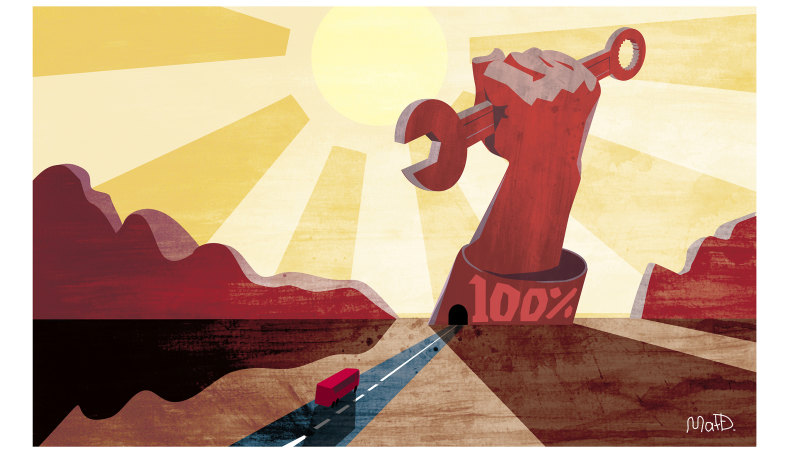Save articles for later
Add articles to your saved list and come back to them any time.
I hope that while you’re complaining about the cost of living, you’re also wallowing in the joys of living in an economy that’s reached the sacred land of “full employment” – being able to provide a job for almost everyone who wants one. This is the first time we’ve seen it in 50 years.
You have to say we’ve achieved it not by design, but as an unexpected consequence of our bumbling attempts to cope with the vicissitudes of the pandemic.
We used interest rates and, more particularly, the budget, to stimulate demand (encourage business and consumer spending) and ended up doing a lot more than we needed to. To the economy managers’ surprise, the rate of unemployment fell rapidly to 3.5 per cent – a level most of them had never seen before and never expected to see.
The sad truth is that, during the half century that the high priests of economics were wandering in the wilderness of joblessness, they lost their faith, and started worshiping the false god Nairu, who whispered in their ears alluring lies about the location they were seeking.
But now the wanderers have stumbled upon the promised land of Full Employment, a land flowing with milk and honey.
We’ve reached “full employment” for the first time in 50 years.Credit: Tamara Voninski
‘Work provides people with a sense of dignity and purpose. Unemployment – particularly long-term unemployment – can be detrimental to a person’s mental and physical health.’
So now’s the time for us all to sing hymns of praise to one true god of mammon, Full Employment, in all its beneficence and beauty. And here to be our worship leader is Michelle Bullock, deputy governor of the Reserve Bank, who published some new soul music this week.
Bullock says it’s “hard to overstate the importance of achieving full employment. When someone cannot find work, or the hours of work they want, they suffer financially. However, the costs of unemployment and underemployment extend well beyond financial impacts.
“Work provides people with a sense of dignity and purpose. Unemployment – particularly long-term unemployment – can be detrimental to a person’s mental and physical health,” she says.
“The costs of not achieving full employment tend to be borne disproportionately by some groups in the community – the young, those who are less educated, and people on lower incomes and with less wealth.
Reserve Bank deputy governor Michelle Bullock: “Full employment is, and has always been, one of our two objectives.”Credit: Oscar Colman
“In fact, for these groups, improved employment outcomes and opportunities to work more hours are much more important for their living standards than wage increases.”
Early in the pandemic and the imposition of lockdowns, we thought we were in for a regular recession. And “the sobering experience from previous recessions had taught us that these episodes leave long-lasting marks on individuals [called “scarring” by economists], communities and the economy.
“For example, if people stay unemployed for too long, their skills may deteriorate or become obsolete and their prospects for re-engaging in meaningful work may decline. This can result in more people in long-term unemployment or, alternatively, people withdrawing from the workforce,” Bullock says.
But, thanks to all the up-front stimulus, there was no recession and, hence, no scarring. Instead, outcomes in the labour market over the past three years “have consistently exceeded the expectations of the Reserve Bank and other forecasters”.
In fact, the share of the Australian population in employment has never been higher – higher even than in the decades between the end of World War II and the mid-1970s, when full employment became the norm.
Today, the number of Australians in a job has increased by more than 1.1 million since late 2021, and the level of employment is now almost 8 per cent above its pre-pandemic level. Get that.
Almost all the gains in employment since the start of the pandemic have been full-time jobs. Strong demand for labour has enabled many previously part-time employees to move into full-time work. This has pushed the underemployment rate – the proportion of people with jobs, but seeking more hours – down to its lowest since 2008.
Bullock says the people who’ve benefited most from all this are those on lower incomes and with less education. Unemployment has tended to decline more in local areas that had weaker employment to begin with.
Does the RBA really consider full employment as important as keeping down inflation?Credit: Louise Kennerley
Young people – those aged 15 to 24 years – who usually suffer most when recessions occur, have seen their rate of unemployment decline by more than twice the decline in the overall unemployment rate.
Long-term unemployment is defined as being without work for more than a year. Last year, a record number of the long-term unemployed found a job, and fewer gave up looking for one.
What’s more, the risk of not being able to find a job within a year declined significantly. So the rate of long-term unemployment is close to its lowest in decades.
Wow. Now, Bullock’s not exaggerating when she says it’s hard to exaggerate the many benefits – economic and social – of achieving full employment.
But she’s harder to believe when she assures us that, just because the Reserve has hardly spoken about anything other than the need to reduce inflation for the past year and more: “it does not mean that the other part of our mandate – maintaining full employment – has become any less important.
“Full employment is, and has always been, one of our two objectives.”
Well, I’d love to believe that was true, but both the Reserve’s present rhetoric and behaviour, and its record, make it hard to believe.
The Reserve has had independent control over the day-to-day management of the economy for more than 35 years. For almost all of that time we’ve had low inflation, but only now have we achieved full employment – and only by happy accident.
For most of that time it, like most macroeconomists the world over, has been listening to the siren call of the false god Nairu – aka the “non-accelerating-inflation rate of unemployment” – telling it that “full employment” really means an unemployment rate of 5 per cent or 6 per cent.
If you dispute that, answer me this: how many times in the past 35 years has a Reserve Bank boss been able to make a similar speech to the one Bullock gave this week?
Ross Gittins is the economics editor.
The Business Briefing newsletter delivers major stories, exclusive coverage and expert opinion. Sign up to get it every weekday morning.
Most Viewed in Business
From our partners
Source: Read Full Article



